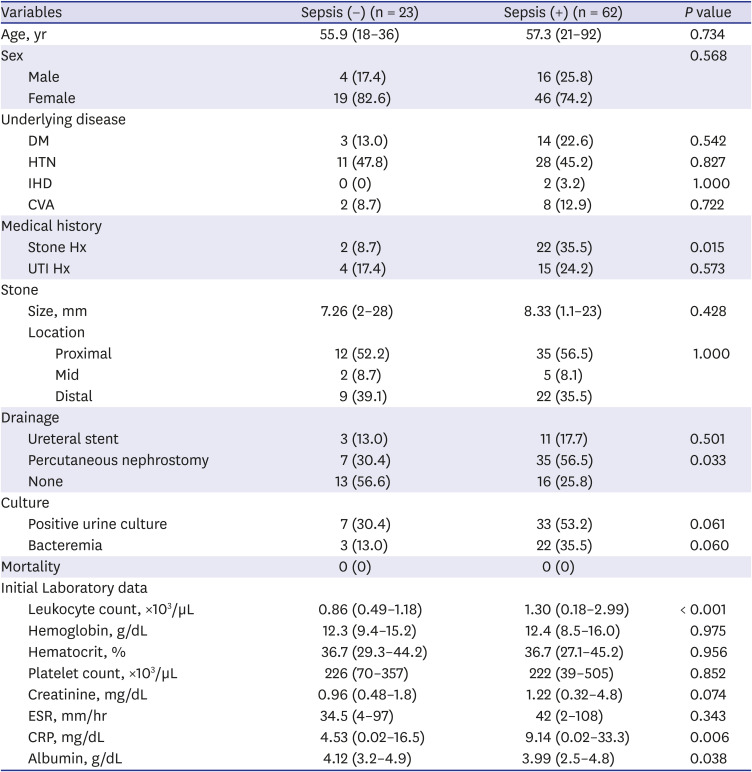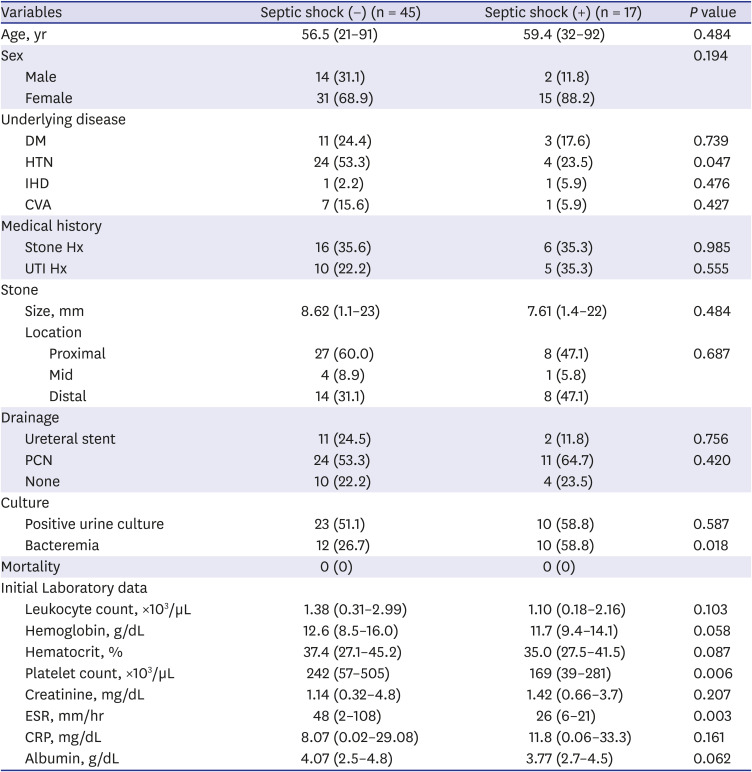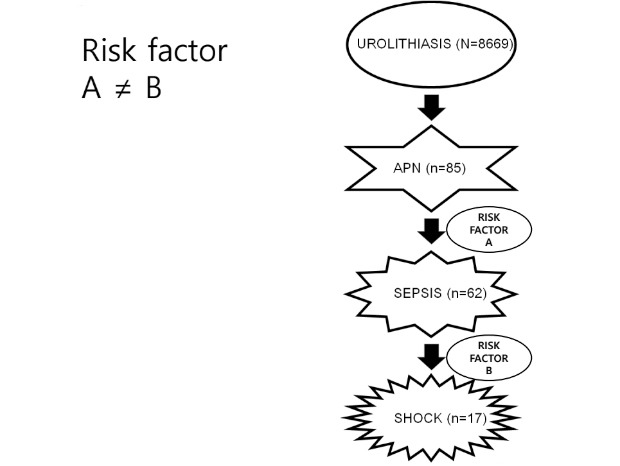1. Foxman B, Klemstine KL, Brown PD. Acute pyelonephritis in US hospitals in 1997: hospitalization and in-hospital mortality. Ann Epidemiol. 2003; 13(2):144–150. PMID:
12559674.
2. Czaja CA, Scholes D, Hooton TM, Stamm WE. Population-based epidemiologic analysis of acute pyelonephritis. Clin Infect Dis. 2007; 45(3):273–280. PMID:
17599303.

3. Kim B, Myung R, Kim J, Lee MJ, Pai H. Descriptive epidemiology of acute pyelonephritis in Korea, 2010–2014: population-based study. J Korean Med Sci. 2018; 33(49):e310. PMID:
30505253.

4. van Nieuwkoop C, van't Wout JW, Spelt IC, Becker M, Kuijper EJ, Blom JW, et al. Prospective cohort study of acute pyelonephritis in adults: safety of triage towards home based oral antimicrobial treatment. J Infect. 2010; 60(2):114–121. PMID:
19945482.

5. Nicolle LE. Urinary tract infection: traditional pharmacologic therapies. Dis Mon. 2003; 49(2):111–128. PMID:
12601341.

6. Danuser H, Ackermann DK, Studer UE. Urological emergencies. Schweiz Med Wochenschr. 1993; 123(15):749–755. PMID:
8488379.
7. Lee JH, Lee YM, Cho JH. Risk factors of septic shock in bacteremic acute pyelonephritis patients admitted to an ER. J Infect Chemother. 2012; 18(1):130–133. PMID:
21861118.

8. Yamamoto Y, Fujita K, Nakazawa S, Hayashi T, Tanigawa G, Imamura R, et al. Clinical characteristics and risk factors for septic shock in patients receiving emergency drainage for acute pyelonephritis with upper urinary tract calculi. BMC Urol. 2012; 12(1):4. PMID:
22413829.

9. Tambo M, Okegawa T, Shishido T, Higashihara E, Nutahara K. Predictors of septic shock in obstructive acute pyelonephritis. World J Urol. 2014; 32(3):803–811. PMID:
24037335.

10. Cawcutt KA, Peters SG. Severe sepsis and septic shock: clinical overview and update on management. Mayo Clin Proc. 2014; 89(11):1572–1578. PMID:
25444488.

11. Efstathiou SP, Pefanis AV, Tsioulos DI, Zacharos ID, Tsiakou AG, Mitromaras AG, et al. Acute pyelonephritis in adults: prediction of mortality and failure of treatment. Arch Intern Med. 2003; 163(10):1206–1212. PMID:
12767958.
12. Singer M, Deutschman CS, Seymour CW, Shankar-Hari M, Annane D, Bauer M, et al. The third international consensus definitions for sepsis and septic shock (sepsis-3). JAMA. 2016; 315(8):801–810. PMID:
26903338.

13. Bone RC, Balk RA, Cerra FB, Dellinger RP, Fein AM, Knaus WA, et al. Definitions for sepsis and organ failure and guidelines for the use of innovative therapies in sepsis. The ACCP/SCCM Consensus Conference Committee. American College of Chest Physicians/Society of Critical Care Medicine. Chest. 1992; 101(6):1644–1655. PMID:
1303622.
14. Levy MM, Fink MP, Marshall JC, Abraham E, Angus D, Cook D, et al. 2001 SCCM/ESICM/ACCP/ATS/SIS international sepsis definitions conference. Crit Care Med. 2003; 31(4):1250–1256. PMID:
12682500.

15. Sprung CL, Annane D, Keh D, Moreno R, Singer M, Freivogel K, et al. Hydrocortisone therapy for patients with septic shock. N Engl J Med. 2008; 358(2):111–124. PMID:
18184957.

16. Annane D, Sébille V, Charpentier C, Bollaert PE, François B, Korach JM, et al. Effect of treatment with low doses of hydrocortisone and fludrocortisone on mortality in patients with septic shock. JAMA. 2002; 288(7):862–871. PMID:
12186604.

17. Wagenlehner FM, Lichtenstern C, Rolfes C, Mayer K, Uhle F, Weidner W, et al. Diagnosis and management for urosepsis. Int J Urol. 2013; 20(10):963–970. PMID:
23714209.

18. Brun-Buisson C. The epidemiology of the systemic inflammatory response. Intensive Care Med. 2000; 26 Suppl 1(Suppl 1):S64–S74. PMID:
10786961.

19. Borofsky MS, Walter D, Shah O, Goldfarb DS, Mues AC, Makarov DV. Surgical decompression is associated with decreased mortality in patients with sepsis and ureteral calculi. J Urol. 2013; 189(3):946–951. PMID:
23017519.

20. Vincent JL. Clinical sepsis and septic shock--definition, diagnosis and management principles. Langenbecks Arch Surg. 2008; 393(6):817–824. PMID:
18584205.

21. Sharaf A, Amer T, Somani BK, Aboumarzouk OM. Ureteroscopy in patients with bleeding diatheses, anticoagulated, and on anti-platelet agents: a systematic review and meta-analysis of the literature. J Endourol. 2017; 31(12):1217–1225. PMID:
29048211.

22. Kamei J, Nishimatsu H, Nakagawa T, Suzuki M, Fujimura T, Fukuhara H, et al. Risk factors for septic shock in acute obstructive pyelonephritis requiring emergency drainage of the upper urinary tract. Int Urol Nephrol. 2014; 46(3):493–497. PMID:
24006032.

23. Clark SR, Ma AC, Tavener SA, McDonald B, Goodarzi Z, Kelly MM, et al. Platelet TLR4 activates neutrophil extracellular traps to ensnare bacteria in septic blood. Nat Med. 2007; 13(4):463–469. PMID:
17384648.

24. Bossink AW, Groeneveld AB, Koffeman GI, Becker A. Prediction of shock in febrile medical patients with a clinical infection. Crit Care Med. 2001; 29(1):25–31. PMID:
11176153.








 PDF
PDF Citation
Citation Print
Print




 XML Download
XML Download